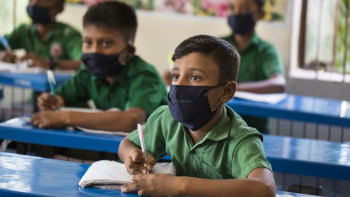How the metaverse can revolutionise education

The concept of "metaverse" – a virtual world where users can interact with each other – was incorporated in the 1992 cyberpunk book Snow Crash, written by Neal Stephenson. This ever-evolving technology has been a catalyst for significant changes across all domains, but the field of metaverse education remains in its infancy.
E-learning's advent may be traced back to the 1990s; however, its worldwide acceptance has been significantly expedited by the onset of the Covid-19 pandemic. Effective education depends on the ability to engage learners, as enhanced participation correlates with higher retention of newly acquired knowledge.
A substantial body of evidence indicates that e-learning may not always be significantly effective in several developing and least-developed countries, including Bangladesh. Worth noting, there exists a regional (urban, semi-urban, and rural) digital divide in education, as a result of unequal access to devices and internet connectivity across regions. This divide has implications for the overall quality and equity of access to education.
The biggest catalyst for stimulating engagement lies with the virtual learning prospects of the metaverse. The utilisation of a virtual and fully-engaging digital environment has the potential to change the education sector.
Despite limited resources and barriers of physical distance, everyone may engage in metaverse-based education if they have access to a basic internet connection and an appropriate device. To reach this goal, the electronics, which may include smartphones and virtual reality (VR) headsets, should be affordable. Regardless of their actual location, students may participate in courses, communicate with instructors and peers, and get involved in collaborative learning experiences via the metaverse. The integration of virtual simulations and real-world interactions inside the metaverse may serve as a helpful complement to hands-on instruction.
This technology implies that students living in underprivileged areas have the opportunity to access a wide range of digital resources, including textbooks, exercises, and expert instructors, which may not be easily accessible in their location. Furthermore, instructors from these areas have the opportunity to participate in training and professional development activities inside the metaverse. This would enable them to enhance their proficiency in digital literacy and teaching methods, eventually leading to positive outcomes for their students.
Simultaneously, several minority groups, including indigenous communities, face challenges in accessing quality schools as a result of linguistic boundaries. The integration of metaverse technology has the potential to enhance inclusivity and relevance by providing educational content in many languages and cultural settings, accommodating the needs of diverse populations.
Although metaverse education exhibits possibilities of mitigating the digital divide, it also raises certain challenges, such as the risk of expanding inequality if not executed fairly and impartially. For example, the absence of high-speed internet may hinder students from engaging in virtual classroom activities and from benefiting from the metaverse's educational resources. In addition, the lack of instructors capable of properly using the metaverse may continue to serve as a serious challenge, despite the availability of sufficient resources.
The paramount importance lies in uninterrupted power supply. It is imperative to acknowledge that the presence of internet services alone is insufficient, as without constant electricity supply, the seamless promotion of metaverse education will be hampered.
Another issue is that instructors in places with poor or high-cost internet may not have the necessary preparation to utilise technology in the classroom. This may result in a disparity in the quality of teaching, as educators with better access to resources may be more proficient in this technology.
Last but not least, manufacturers of metaverse devices heavily rely on acquiring extensive personal information about users. For instance, Facebook accounts are required for those who want to utilise the company's VR headsets. Additionally, the headsets can capture very private and sensitive information including location, user's physical attributes and motions, and voice. Meta has not provided any guarantees that the data would be kept confidential. Consequently, there is always a possibility of security breach.
In summary, it is of utmost importance to address the digital divide to guarantee equitable access to high-quality education for all students, irrespective of their geographical location. The use of metaverse education holds promise as an effective instrument for mitigating this divide, providing students equal access to learning opportunities. However, given the infancy of the system, it is readily apparent that the government alone might not be able to manage this endeavour. Non-governmental organisations and donor agencies can consider investing in metaverse infrastructure and pilot projects to facilitate equitable access to educational opportunities for underprivileged communities.
Dr Najmul Hasan is an assistant professor and researcher in information systems at Brac Business School, Brac University. He is also a visiting academic at the School of Information and Physical Sciences (Data Science and Statistics),University of Newcastle, Australia.
Views expressed in this article are the author's own.
Follow The Daily Star Opinion on Facebook for the latest opinions, commentaries and analyses by experts and professionals. To contribute your article or letter to The Daily Star Opinion, see our guidelines for submission.

 For all latest news, follow The Daily Star's Google News channel.
For all latest news, follow The Daily Star's Google News channel. 









Comments